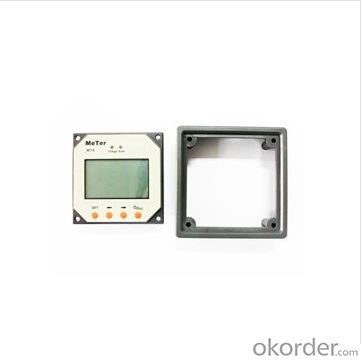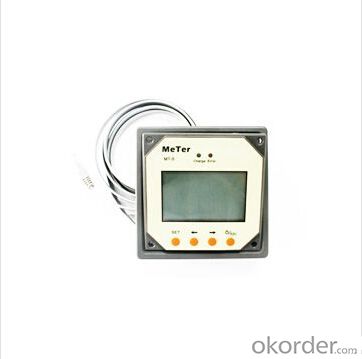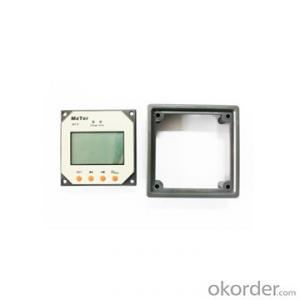Remote Display for Tracer Series,Remote Meter MT-5
- Loading Port:
- Tianjin
- Payment Terms:
- TT or LC
- Min Order Qty:
- 50 pc
- Supply Capability:
- 5000 pc/month
OKorder Service Pledge
OKorder Financial Service
You Might Also Like
MT-5 is an optional accessory for Tracer series solar charge controller. The LCD displays the system status and parameters clearly.
Features:
·Display the system status and parameters with digital and graphic icon.
·Battery type selectable
·Battery Ah setting function
·Temperature compensation coefficient adjustable
·Four keys to solve the setting easily
·Control the load by manual
Specification:
Rated voltage | 12V, min voltage (suggest): 8.0V |
Strong backlight on | <23mA |
Low backlight on | <20mA |
Backlight and LED indicator off | <17mA |
Operation temperature | -40℃ ~ +60℃ |
LCD operation temperature | -10℃ ~ +40℃ |
Humidity | 0-100% |
Communication cable | RJ45(8PIN), 2 meter |
Battery voltage parameters (temperature at 25°C) | |||
Battery charging setting | Sealed | Flooded | Gel |
Equalize charging voltage | 14.4 V;x2/24V | 14.6V;x2/24V | 14.8V;x2/24V |
Boost charging voltage | 14.2V;x2/24V | 14.4V;x2/24V | 14.6V;x2/24V |
Float charging voltage | 13.7V;x2/24V | 13.7V;x2/24V | 13.7V;x2/24V |
Max. solar voltage | 30V(12V system),55V(24V system) | ||
Battery voltage range | 8-15V(12V system),8-30V(24V system) | ||
Self-consumption | 4mA at night, 10mA at charging | ||


FAQ:
Q1. What is the voltage?
A1. Our 45/60A solar charge controller is 12/24/36/48V auto work.
Q2. What is the difference between MPPT&PWM?
A2. MPPT has higher efficiency, it can track the max power point and won't waste energy.
Q3. What is the efficiency of the MPPT controller?
A3. MPPT>99%, peak conversion efficiency>98%.
Q4. What is the waranty of product?
A4. 12 months.
Q5. What protection does your MPPT controller have?
A5. PV array short circuit, PV reverse polarity, Battery reverse polarity, Over charging, Output short circuit.
- Q:How does a solar controller handle power surges from the solar panels?
- A solar controller is a critical component in a solar power system that regulates the flow of power from the solar panels to the battery bank or the electrical grid. When it comes to handling power surges from the solar panels, a solar controller plays a crucial role in safeguarding the system. Power surges can occur due to various reasons such as sudden changes in weather conditions, fluctuations in solar radiation, or issues with the solar panel itself. These surges can potentially damage the system and its components if not handled properly. To handle power surges, a solar controller typically incorporates various protective mechanisms. One of the primary functions of a solar controller is to prevent overcharging of the battery bank. When a power surge occurs, the solar controller detects the excess voltage and current and limits the charging rate to ensure that the battery is not overcharged. This helps to maintain the battery's health and prolong its lifespan. Furthermore, solar controllers often include transient voltage suppression devices like surge protectors or voltage clamps. These devices help to absorb and divert excessive voltage spikes away from the system, preventing damage to the solar panels, controller, batteries, or other connected devices. Additionally, some advanced solar controllers employ Maximum Power Point Tracking (MPPT) technology, which optimizes the power output of the solar panels. MPPT controllers can dynamically adjust the voltage and current to maximize the power transfer from the panels to the battery, even during power surges. This technology improves the efficiency of the system while also minimizing the impact of power fluctuations. In conclusion, a solar controller handles power surges from the solar panels by regulating the charging rate to prevent overcharging, incorporating surge protection devices, and utilizing MPPT technology to optimize power output. These protective features ensure the system's stability, protect the components from damage, and maximize the efficiency of the solar power system.
- Q:Choose a solar controller which need to have a few conditions
- The controller should have battery overvoltage protection, battery undervoltage protection, load short circuit protection, temperature compensation and other functions, select the controller to choose the quality of the guarantee. Big manufacturers big brand
- Q:Can a solar controller be used with solar panels of different orientations?
- Solar panels of different orientations can indeed be used with a solar controller. The solar controller's role is to regulate the energy flow between the solar panels and the battery or load, and this is unaffected by the panels' orientation. Monitoring the battery's charge level and preventing overcharging or discharging are the primary functions of the solar controller. Therefore, as long as the solar panels are connected to the controller and it is correctly set up, it can effectively manage the energy flow regardless of the panels' orientations. It is worth mentioning, however, that the efficiency of the solar panels may vary depending on their orientation towards the sun, which can impact the overall performance of the solar system.
- Q:Can a solar controller be used in a solar-powered telecommunications system?
- Yes, a solar controller can be used in a solar-powered telecommunications system. A solar controller, also known as a charge controller, is an essential component that regulates and controls the flow of electricity from the solar panels to the batteries. It ensures that the batteries are charged efficiently and protects them from overcharging or excessive discharging. In a solar-powered telecommunications system, the solar controller plays a crucial role in managing the energy generated by the solar panels, ensuring reliable power supply for the communication equipment.
- Q:Can a solar controller be used with solar-powered indoor government buildings?
- Yes, a solar controller can be used with solar-powered indoor government buildings. A solar controller, also known as a charge controller, is an essential component of a solar power system. Its primary function is to regulate the flow of electricity between the solar panels and the batteries, ensuring that the batteries are charged efficiently and preventing overcharging or damage to the batteries. Solar-powered indoor government buildings typically utilize solar panels to generate electricity from sunlight. This electricity is then used to power various devices and systems within the building. In such cases, a solar controller is necessary to manage the charging process of the batteries that store the solar energy. By connecting the solar panels to the solar controller and then to the batteries, the solar controller can accurately monitor and control the charging process, maximizing the efficiency and lifespan of the batteries. Additionally, solar controllers often provide other useful functionalities, such as temperature compensation, load control, and battery protection. These features are particularly important for indoor government buildings, as they help optimize the performance of the solar power system and ensure reliable and sustainable power supply. Therefore, it is highly recommended to use a solar controller in conjunction with solar-powered indoor government buildings to ensure efficient and safe operation of the solar power system.
- Q:Can a solar controller be used with a solar-powered agricultural irrigation system?
- Yes, a solar controller can be used with a solar-powered agricultural irrigation system. A solar controller is designed to regulate and optimize the performance of solar panels, batteries, and other components in a solar power system. It helps to manage the charging and discharging of batteries, control the flow of electricity, and ensure efficient energy usage. In the case of a solar-powered agricultural irrigation system, a solar controller can play a crucial role in maintaining the proper functioning of the system. It can monitor the energy production from the solar panels and regulate the charging of batteries to ensure a steady and reliable power supply. This is especially important for irrigation systems as they often require a continuous power source to pump water and operate other components. Furthermore, a solar controller can also help in controlling the timing and duration of irrigation cycles. It can be programmed to activate the irrigation system during specific daylight hours when solar energy production is at its peak. This helps in maximizing the use of solar power and reduces the dependency on grid electricity or backup generators. Overall, a solar controller is a valuable component in a solar-powered agricultural irrigation system as it enhances the efficiency, reliability, and sustainability of the system.
- Q:What is the maximum temperature rating for a solar controller?
- The maximum temperature rating for a solar controller can vary depending on the specific model and manufacturer. However, most high-quality solar controllers are designed to operate in a wide range of temperatures, typically between -40°C to 85°C (-40°F to 185°F). These temperature ranges ensure that the controller can withstand extreme weather conditions, such as hot summers or cold winters, without compromising its performance or durability. It is important to consult the manufacturer's specifications or user manual to determine the maximum temperature rating for a specific solar controller model.
- Q:Can a solar controller be used with a battery bank that has different state of charge levels?
- Yes, a solar controller can be used with a battery bank that has different state of charge levels. The solar controller regulates the charging process and ensures that each battery in the bank is charged to its optimal level, regardless of the differences in state of charge. This helps to maintain the overall health and performance of the battery bank.
- Q:Are there any safety concerns with using a solar controller?
- Yes, there can be safety concerns with using a solar controller. These concerns mainly revolve around electrical safety, such as the risk of electrical shock or fire if the controller is not installed, wired, or maintained properly. It is important to follow all the manufacturer's instructions and guidelines and ensure that the controller is installed and used in compliance with relevant electrical codes and regulations. Regular inspections and maintenance are also recommended to mitigate any potential safety risks.
- Q:How does a solar controller monitor the battery voltage?
- A solar controller monitors the battery voltage by constantly measuring the voltage level of the battery. It typically has built-in sensors that measure the voltage and send this information to the controller. This allows the controller to regulate the charging process and prevent overcharging or undercharging of the battery, ensuring its optimal performance and longevity.
1. Manufacturer Overview |
|
|---|---|
| Location | |
| Year Established | |
| Annual Output Value | |
| Main Markets | |
| Company Certifications | |
2. Manufacturer Certificates |
|
|---|---|
| a) Certification Name | |
| Range | |
| Reference | |
| Validity Period | |
3. Manufacturer Capability |
|
|---|---|
| a)Trade Capacity | |
| Nearest Port | |
| Export Percentage | |
| No.of Employees in Trade Department | |
| Language Spoken: | |
| b)Factory Information | |
| Factory Size: | |
| No. of Production Lines | |
| Contract Manufacturing | |
| Product Price Range | |
Send your message to us
Remote Display for Tracer Series,Remote Meter MT-5
- Loading Port:
- Tianjin
- Payment Terms:
- TT or LC
- Min Order Qty:
- 50 pc
- Supply Capability:
- 5000 pc/month
OKorder Service Pledge
OKorder Financial Service
Similar products
New products
Hot products
Related keywords





























